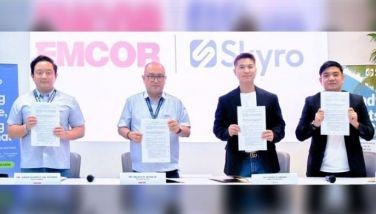Efforts vs hepatitis B intensified
September 8, 2005 | 12:00am
BALI, Indonesia – Liver experts from all over the Asia-Pacific region convened here recently to intensify their efforts against hepatitis B, a life-threatening viral infection that affects two billion people worldwide.
They shared radical information on the latest researches and discoveries on hepatitis B and other liver-related diseases during the 15th Conference of the Asia-Pacific Association for the Study of the Liver (APASL) held at the Bali International Convention Center.
Some 2,000 physicians, pharmacologists and people from other concerned sectors attended the four-day event.
Dr. Jose Sollano, former president of the Philippine Society of Gastroenterology and Digestive Endoscopy, said hepatitis B is of great concern in the Asia-Pacific because the region is home to 75 percent of the 350 million people who have progressive or chronic hepatitis B (CHB).
CHB is the primary cause of liver cancer, which kills 2,700 people daily worldwide, as well as epatocellular carcinoma (HCC) and cirrhosis or liver scarring.
"The study of the liver has seen tremendous advances in recent years and many Asian hepatologists have contributed greatly to this accumulation of knowledge… It is therefore appropriate that we convene yearly and share our scientific and clinical experiences with our colleagues in Asia and with the rest of the world," Sollano said.
The Philippines will host the conference on March 5-8, 2006.
Sollano said no one has to suffer from hepatitis B complications because of latest strategies in diagnosis and treatment of liver disorders.
One of the medical breakthroughs presented during the conference was the discovery of Entecavir, an oral antiviral therapy approved by the US Food and Drug Administration a few months ago.
Manufactured by Bristol-Myers Squibb, Entecavir was designed to block the replication of hepatitis B virus in the body by interfering with the virus’ ability to infect cells.
According to Prof. Chien-Jen Chen, Taiwan’s former health minister and vice chairman of the National Science Council of Taiwan, there are "predictive factors" that determine the progression of CHB into liver cancer, HCC or cirrhosis.
These factors include age, gender, alcohol consumption, smoking and the level of serum hepatitis B virus DNA (HBV DNA).
"Treatment strategies that result in effective suppression of HBV DNA to undetectable levels are expected to reduce the risk of disease progression to cirrhosis or HCC in CHB patients," he said.
For Prof. Rosmawati Mohamed, former president of the Malaysian Society of Gastroenterology and Hepatology, hepatitis B is "50 to 100 times more infectious than the human immunodeficiency virus (HIV)."
But despite the hazard posed by CHB, only four percent of those infected are actually receiving treatment.
"Lack of disease awareness, changing patterns of prevalence and (lack of) up-to-date knowledge of treatment options all present barriers to initiating appropriate treatment in CHB patients," she said.
Sollano said about 9.5 million Filipinos are suffering from hepatitis B but most of them are not aware of their condition.
The disease can be spread through contaminated blood or blood products. Transmission can also occur among injecting drug users or between sexual partners.
Pregnant women infected with the virus have a 20 to 30 percent chance of passing on the illness to their children.
He said the best way to fight hepatitis B is to make it mandatory to immunize newborns against the illness within 12 hours from birth.
"But the biggest challenge for us is to reach out to those who are born outside the health facilities, those who are not even seen by doctors," he said.
There is also a need to raise awareness of hepatitis B because many Filipinos believe that the illness could cause their immediate death.
"We have to make the Filipinos aware that there are treatments that can assure them quality life. But we also have to make these drugs accessible and affordable for them. That is also a challenge for us," Sollano said.
They shared radical information on the latest researches and discoveries on hepatitis B and other liver-related diseases during the 15th Conference of the Asia-Pacific Association for the Study of the Liver (APASL) held at the Bali International Convention Center.
Some 2,000 physicians, pharmacologists and people from other concerned sectors attended the four-day event.
Dr. Jose Sollano, former president of the Philippine Society of Gastroenterology and Digestive Endoscopy, said hepatitis B is of great concern in the Asia-Pacific because the region is home to 75 percent of the 350 million people who have progressive or chronic hepatitis B (CHB).
CHB is the primary cause of liver cancer, which kills 2,700 people daily worldwide, as well as epatocellular carcinoma (HCC) and cirrhosis or liver scarring.
"The study of the liver has seen tremendous advances in recent years and many Asian hepatologists have contributed greatly to this accumulation of knowledge… It is therefore appropriate that we convene yearly and share our scientific and clinical experiences with our colleagues in Asia and with the rest of the world," Sollano said.
The Philippines will host the conference on March 5-8, 2006.
Sollano said no one has to suffer from hepatitis B complications because of latest strategies in diagnosis and treatment of liver disorders.
One of the medical breakthroughs presented during the conference was the discovery of Entecavir, an oral antiviral therapy approved by the US Food and Drug Administration a few months ago.
Manufactured by Bristol-Myers Squibb, Entecavir was designed to block the replication of hepatitis B virus in the body by interfering with the virus’ ability to infect cells.
According to Prof. Chien-Jen Chen, Taiwan’s former health minister and vice chairman of the National Science Council of Taiwan, there are "predictive factors" that determine the progression of CHB into liver cancer, HCC or cirrhosis.
These factors include age, gender, alcohol consumption, smoking and the level of serum hepatitis B virus DNA (HBV DNA).
"Treatment strategies that result in effective suppression of HBV DNA to undetectable levels are expected to reduce the risk of disease progression to cirrhosis or HCC in CHB patients," he said.
For Prof. Rosmawati Mohamed, former president of the Malaysian Society of Gastroenterology and Hepatology, hepatitis B is "50 to 100 times more infectious than the human immunodeficiency virus (HIV)."
But despite the hazard posed by CHB, only four percent of those infected are actually receiving treatment.
"Lack of disease awareness, changing patterns of prevalence and (lack of) up-to-date knowledge of treatment options all present barriers to initiating appropriate treatment in CHB patients," she said.
Sollano said about 9.5 million Filipinos are suffering from hepatitis B but most of them are not aware of their condition.
The disease can be spread through contaminated blood or blood products. Transmission can also occur among injecting drug users or between sexual partners.
Pregnant women infected with the virus have a 20 to 30 percent chance of passing on the illness to their children.
He said the best way to fight hepatitis B is to make it mandatory to immunize newborns against the illness within 12 hours from birth.
"But the biggest challenge for us is to reach out to those who are born outside the health facilities, those who are not even seen by doctors," he said.
There is also a need to raise awareness of hepatitis B because many Filipinos believe that the illness could cause their immediate death.
"We have to make the Filipinos aware that there are treatments that can assure them quality life. But we also have to make these drugs accessible and affordable for them. That is also a challenge for us," Sollano said.
BrandSpace Articles
<
>
- Latest
Latest
Latest
October 25, 2024 - 9:00am
October 25, 2024 - 9:00am
October 24, 2024 - 11:20am
October 24, 2024 - 11:20am
October 14, 2024 - 11:00am
October 14, 2024 - 11:00am
October 11, 2024 - 12:49pm
October 11, 2024 - 12:49pm
September 30, 2024 - 8:00am
September 30, 2024 - 8:00am
September 26, 2024 - 2:00pm
September 26, 2024 - 2:00pm
Recommended






























